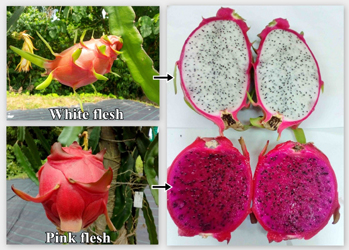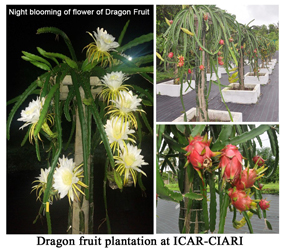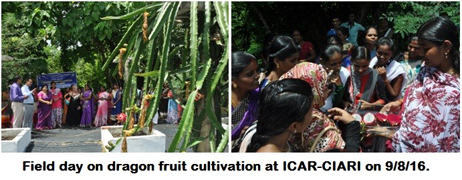Port Blair.
The dragon fruit (Hylocereus sp.), a new introduction in India, is highly valued for its reported neutraceutical properties. It is a climbing vine cactus species with most beautiful fruit in the family Cactaceae that has beautiful flowers and is nicknamed as ‘Noble woman’ or ‘Queen of the Night’. The juicy flesh of the fruit is delicious in taste. Five different collections of dragon fruit are collected and established at the experimental farm of Central Island Agricultural Research Institute. As dragon fruit is climbing cacti, support is essential for their growth and development. Our scientists used concrete poles as trellises for durability of the plant as the life of the vines is as long as 20 years. The concrete pillars are supported by a square structure in the top to train the vine for bearing purpose. Since the island is high rainfall zone, soil erosion is the common problem and hence scientists have made concrete square structures as base for maintaining the media that supports the growth of the vine.

Alternatively our scientists initiated cost effective structures using iron poles and used tyres as base structure. The structures are made at a spacing of 3 m ×3 m. The media consisted of the soil enriched with organic inputs like farmyard manure, coir compost and vermin-compost along with biofertilizers. The rooted cuttings of dragon fruit accessions were planted in June, 2015 @ of 4 cuttings around each concrete pillar. The growth of dragon fruit vines was so fast that an average growth rate of 8.2 cm was observed per week. The reported rainfall requirement of dragon fruit is 1,145- 2,540 mm/year. Since the rainfall is distributed for eight months in the Island, irrigation is not required but in the dry season, the growing media is kept moist by irrigation through drip system on alternate days. Weed control is an important operation in dragon fruit cultivation and the use of weed mat efficiently reduced the weeds growth and also aids in soil moisture conservation. In about 8 months after planting the dragon fruit forms a thick dense mass of vines on top of the trellis which lies drooping to the ground.

The flowering was initiated in the red fleshed and white fleshed dragon fruits in the month of March, 2016 (nine months after planting). Dragon fruits become ready for harvesting in 25-35 days after flowering. The maturity index of the fruit is colour breaking stage from bright green colour to red colour. Exact time of harvesting is 3 to 4 days after colour change for local market. But in case of long distance transport/export, the fruits are to be harvested when the colour break is noticed. The fruits are harvested at our Institute from June, 2016. The dragon fruit plantation is maintained at Central Island Agricultural Research Institute with only organic agricultural practices. The initial establishment cost is little high in the dragon fruit especially for the construction of trellis but once the plants are established, the fruits can be harvested continuously upto 20 years. After establishment of the crop, only minimum expenses are required for maintenance of the dragon fruit plantation. This dragon fruit is packed with excellent health benefits and has good demand in local as well as international markets. In the Islands too, the fruits have good demand and imported fruits are marketed presently at the rate of Rs 200 to 250 / kg. Dragon fruit cultivation in the islands could be a viable option for farmers and entrepreneurs of medium to large scale plantations. It is a fast return potential fruit crop with production in the second year of planting.

The on farm demonstration of dragon fruit at Central Island Agricultural Research Institute has drawn the interest of farmers and entrepreneurs and a field day was conducted to popularize the dragon fruit cultivation among the Island farmers on 9 August 2016. A total of 52 farmers from different villages of South Andaman attended the field day. The visiting farmers relished the dragon fruits organically produced at the Institute and learnt the growth and development of the crop. The farmers were highly fascinated by the new fruit crop and showed lots of enthusiasm for learning the technical know-how of this fruit crop.
(Source: ICAR- Central Island Agricultural Research Institute, Port Blair)








Like on Facebook
Subscribe on Youtube
Follow on X X
Like on instagram